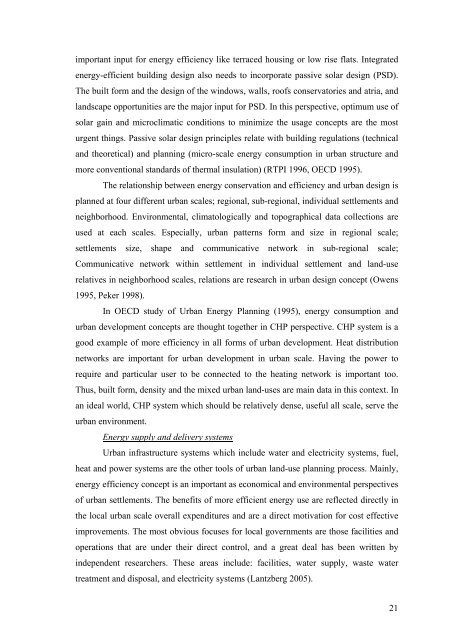developing a strategic decision-making process for local energy ...
developing a strategic decision-making process for local energy ...
developing a strategic decision-making process for local energy ...
You also want an ePaper? Increase the reach of your titles
YUMPU automatically turns print PDFs into web optimized ePapers that Google loves.
important input <strong>for</strong> <strong>energy</strong> efficiency like terraced housing or low rise flats. Integrated<br />
<strong>energy</strong>-efficient building design also needs to incorporate passive solar design (PSD).<br />
The built <strong>for</strong>m and the design of the windows, walls, roofs conservatories and atria, and<br />
landscape opportunities are the major input <strong>for</strong> PSD. In this perspective, optimum use of<br />
solar gain and microclimatic conditions to minimize the usage concepts are the most<br />
urgent things. Passive solar design principles relate with building regulations (technical<br />
and theoretical) and planning (micro-scale <strong>energy</strong> consumption in urban structure and<br />
more conventional standards of thermal insulation) (RTPI 1996, OECD 1995).<br />
The relationship between <strong>energy</strong> conservation and efficiency and urban design is<br />
planned at four different urban scales; regional, sub-regional, individual settlements and<br />
neighborhood. Environmental, climatologically and topographical data collections are<br />
used at each scales. Especially, urban patterns <strong>for</strong>m and size in regional scale;<br />
settlements size, shape and communicative network in sub-regional scale;<br />
Communicative network within settlement in individual settlement and land-use<br />
relatives in neighborhood scales, relations are research in urban design concept (Owens<br />
1995, Peker 1998).<br />
In OECD study of Urban Energy Planning (1995), <strong>energy</strong> consumption and<br />
urban development concepts are thought together in CHP perspective. CHP system is a<br />
good example of more efficiency in all <strong>for</strong>ms of urban development. Heat distribution<br />
networks are important <strong>for</strong> urban development in urban scale. Having the power to<br />
require and particular user to be connected to the heating network is important too.<br />
Thus, built <strong>for</strong>m, density and the mixed urban land-uses are main data in this context. In<br />
an ideal world, CHP system which should be relatively dense, useful all scale, serve the<br />
urban environment.<br />
Energy supply and delivery systems<br />
Urban infrastructure systems which include water and electricity systems, fuel,<br />
heat and power systems are the other tools of urban land-use planning <strong>process</strong>. Mainly,<br />
<strong>energy</strong> efficiency concept is an important as economical and environmental perspectives<br />
of urban settlements. The benefits of more efficient <strong>energy</strong> use are reflected directly in<br />
the <strong>local</strong> urban scale overall expenditures and are a direct motivation <strong>for</strong> cost effective<br />
improvements. The most obvious focuses <strong>for</strong> <strong>local</strong> governments are those facilities and<br />
operations that are under their direct control, and a great deal has been written by<br />
independent researchers. These areas include: facilities, water supply, waste water<br />
treatment and disposal, and electricity systems (Lantzberg 2005).<br />
21
















